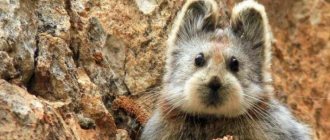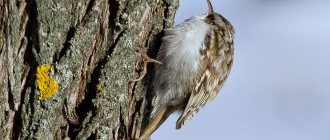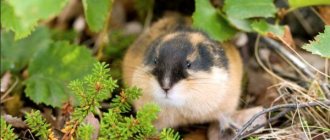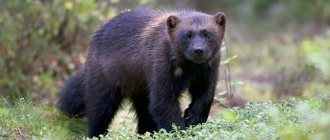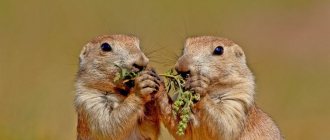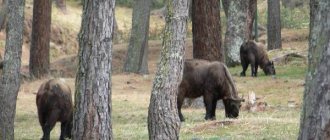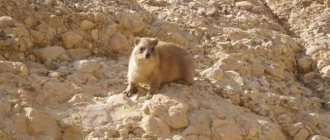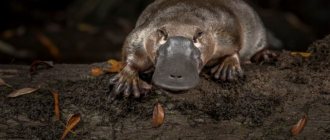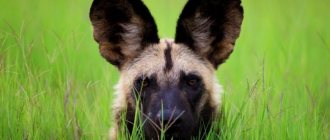- Wild animals
- >>
- Mammals
The pika is a small, short-legged, nearly tailless, ovoid mammal native to the mountains of western North America and much of Asia. Despite their small size, body shape and round ears, pikas are not rodents, but the smallest representatives of lagomorphs; otherwise, this group is represented by hares and rabbits (family Lagoraceae).
Origin of the species and description
Photo: Pika
Pikas have many common names, most of which apply to specific forms or species. The names mouse-hare are sometimes used, although the pika is neither a mouse nor a hare. The genus name comes from the Mongolian ochodona, and the term “pika” - “pika” - comes from the folk “piika” of the Tungus, a tribe from northeastern Siberia.
The pika is the only living genus of the family Lagomorphs, whose members lack some of the special skeletal modifications present in hares and rabbits (family Lagoraceae), such as a strongly convex skull, a relatively upright head position, strong hind limbs and pelvic girdle, and elongated limbs.
Video: Pika
The pika family was clearly differentiated from other lagomorphs back in the Oligocene era. The pika first appeared in the fossil record during the Pliocene in Eastern Europe, Asia, and western North America. Its origin was probably in Asia. By the Pleistocene, the pika was found in the eastern United States and as far west in Europe as Great Britain.
This widespread expansion was followed by a limitation of its current range. One fossil pika (genus Prolagus) apparently lived during historical times. Her remains were found in Corsica, Sardinia and neighboring small islands. Previously, the fossil material had been found on the Italian mainland. It was apparently still present until 2000 years ago, but was forced into extinction, probably due to habitat loss and competition and predation from introduced animals.
Appearance and features
Photo: What a pika looks like
The 29 pika species are remarkably uniform in body proportions and position. Their fur is long and soft and usually grayish-brown in color, although some species are rusty red. Unlike rabbits and hares, the hind limbs of pikas are not noticeably longer than the front ones. The legs, including the soles, are densely covered with hair, with five toes at the front and four at the back. Most pikas weigh between 125 and 200 grams and are about 15 cm long.
Fun fact: The average annual mortality rate for pikas ranges from 37 to 53%, and age-specific mortality is highest for children aged 0 to 1 year and 5 to 7 years. The maximum age of pikas in the wild and in captivity is 7 years, and the average lifespan in the wild is 3 years.
In certain parts of their range, males are larger than females, but only slightly. Their body is ovoid, with short ears, long whiskers (40-77 mm), short limbs and no visible tail. Their hind feet are digitally shaped, have four toes (compared to five on the front) and range from 25 to 35 mm in length.
Both sexes have pseudoclacal openings that must be opened to expose the penis or clitoris. Females have six mammary glands, which do not enlarge during lactation. Pikas have a high body temperature (average 40.1°C) and a relatively low upper lethal temperature (average 43.1°C). They have a high metabolic rate, and their thermoregulation is behavioral rather than physiological.
Fun Fact: The pika's fur color varies with the seasons, but retains an off-white shade on its ventral surface. On the dorsal surface, the fur varies from grayish to cinnamon-brown in summer. In winter, their dorsal fur is gray and twice as long as their summer coat.
Their ears are round, covered with dark hair on the inner and outer surfaces and edged with white. Their feet are densely covered with hair, including the soles, except for small black hairless pads at the ends of the toes. Their skull is slightly rounded, with a flat, wide interorbital region.
Description of the bird
The pika is a small songbird from the genus of the same name in the passerine order. The body length of pikas is about 12 cm, weight – from 7 to 13 g.
The plumage on the back is beige-brown, decorated with dark spots, the belly is light gray. All representatives of the species have a noticeable curved beak, brown elytra with figured patterns, and white feathers under the wings. The hard feathers of the pika's brown tail help the bird to deftly climb tree trunks in search of food, but the pika does not move up or down head first.
Where does the pika live?
Photo: Pika in Russia
The pika is usually found in mountainous areas at high elevations. Two species are found in North America, the rest are found mainly throughout Central Asia. 23 of them live wholly or partly in China, especially on the Tibetan Plateau.
There are two distinctly different ecological niches occupied by pikas. Some live only in piles of broken rock (talus), while others live in grassland or steppe environments where they build burrows. North American species and about half of Asian species live in rocky habitats and do not make burrows. Rather, their nests are made deep in a maze of scree adjacent to alpine meadows or other suitable vegetation.
The pika has been found in Alaska and northern Canada on isolated nunataks (cliffs or peaks surrounded by glaciers) in Kluane National Park. It has also been spotted at an altitude of 6,130 meters on the slopes of the Himalayas. The pika with the largest distribution, the northern pika, ranges from the Urals to the east coast of Russia and the island of Hokkaido in northern Japan. Although the northern pika is considered a typical talus species, it also inhabits rocky terrain in coniferous forests, where it makes burrows under fallen logs and stumps.
Now you know where the pika lives. Let's see what the rodent eats.
Habitat
The best habitat for pikas are places where a cold climate prevails. There are species for which rocky mountainous areas are suitable for life, where there are many crevices on the slopes. Some Ili pikas dig burrows there; for other species it is an excellent refuge from predators. Big-eared and red pikas often inhabit large rocky screes; Altai pikas sometimes inhabit tree roots and piles of dead wood.
Several species of hay farms have chosen the steppe as their place of residence. The following pikas are considered steppe inhabitants: Mongolian, Daurian, black-lipped, steppe. Ili pikas are colonial creatures; they live in entire settlements, in which there are sometimes from several tens to thousands of wonderful animals.
What does a pika eat?
Photo: Pika rodent
The pika is a herbivore and therefore has a plant-based diet.
The pika is a diurnal animal and during the daytime it feeds on the following foods:
- grass;
- seeds;
- weeds;
- thistle;
- berries.
Pikas eat some of their collected plants fresh, but most become part of their winter stores. Much of their short summer is spent gathering plants to create haystacks. Once the haystack is completed, they begin another.
Pikas do not hibernate and are generalized herbivores. Where snow surrounds their environment (as it often does), they build caches of vegetation called hayfields to provide food during the winter. A characteristic behavior of stone pikas in the summer is their repeated trips to meadows adjacent to talus to collect plants for hay.
Fun Fact: One oft-repeated but incorrect story is that pikas place their hay on rocks so it can dry out before storing it. Pikas will most likely carry their food directly into the hay if left undisturbed.
Like other lagomorphs, pikas practice coprophagy to obtain additional vitamins and nutrients from their relatively low-quality food. Pikas create two types of fecal droppings: a hard brown round pellet and a soft shiny strand of material (a blind pellet). The pika consumes the cecal sediment (which has a high energy value and protein content) or stores it for later consumption. Only about 68% of food consumed is digested, making cecal pellets an important part of the pika's diet.
Keeping pikas at home
The common pika and related species are not bred in captivity. This bird does not adapt well to home conditions; it is difficult to find the necessary food for it and provide it with space and movement. You can observe the agility of pikas and enjoy their melodic whistling singing in nature, in parks and gardens.
Features of character and lifestyle
Photo: Pika animal
The degree of social behavior varies among pika species. Rock pikas are relatively asocial and occupy widely spaced, scent-marked territories. They announce their presence to each other by frequently making short calls (usually "enk" or "eh-ehh"). Thus, rock-dwelling pikas are able to track neighbors by directly encountering them only once or twice a day. Such encounters usually result in aggressive pursuit.
In contrast, burrowing pikas live in family groups, and these groups occupy and defend a common territory. Within the group, social encounters are numerous and generally friendly. Pikas of all ages and both sexes may groom each other, rub their noses, or sit side by side. Aggressive encounters, usually in the form of long pursuits, occur only when an individual from one family group violates the territory of another.
Burrowing pikas also have a much larger vocal repertoire than rock pikas. Many of these calls signal cohesion in family groups, especially among juveniles from successive litters or between males and juveniles. All pikas make short alarm calls when they see predators. Males make a long call or song during mating season.
Unlike rabbits and hares, pikas are active during the day, with the exception of nocturnal steppe pikas. Being primarily alpine or boreal species, most pikas are adapted to living in cold environments and do not tolerate heat. When temperatures are high, they limit their activities to the early morning and late afternoon.
Social structure and reproduction
Photo: Steppe pika
There is a contrast between rock pikas and burrowing pikas that extends to their reproduction. Rock pikas typically produce only two litters per year, and typically only one of them is successfully weaned. The second litter is only considered successful when the first offspring dies early in the breeding season. Litter size is low for most mountain dwellers, but burrowing pikas can produce several large litters each season. The prairie pika has been reported to have litters of up to 13 young and breeds up to five times a year.
The mating season of pikas lasts from April to July. They may breed twice a year depending on their location. The gestation period lasts thirty days (one month). During the mating season, male and female pikas in opposite territories call each other and form a pair bond.
Pikas use traces of urine and feces to mark scents. Cheek markings derived from apocrine sweat glands are used to attract potential mates and demarcate territories. They are common in both sexes, who rub their cheeks on rocks. During the breeding season or when settling into a new territory, pikas rub their cheeks with increased frequency. Urine and feces are usually placed in hay as a sign of ownership.
The female pika is capable of producing two litters per year, but typically only one will result in successful young. The female gives birth to 1 to 5 children after a gestation period of about a month. When children are old enough to be independent, they often settle down close to their parents.
Interesting fact: The young are completely dependent on their mother for at least 18 days. They have a fast growth rate and reach adult size when they are only 3 months old. The female weans the cubs 3-4 weeks after birth.
Natural enemies of pikas
Photo: Pika
Although the pika lives in regions where few other animals are present, it has many predators, mainly due to its small size. The weasel is the main predator of pikas, along with birds of prey, dogs, foxes and cats. Pikas are moderately camouflaged and, when a potential predator is detected, they produce an alarm call informing the rest of the community of its presence. Alarm calls are made less frequently for small predators, as small predators may chase them into gaps in the talus.
Small predators consist of long-tailed weasels (Mustela frenata) and stoats (Mustela erminea). Large predators such as coyotes (Canis latrans) and American martens (Martes americana) are particularly adept at capturing juveniles that are not fast enough to escape. Golden eagles (Aquila chrysaetos) also feed on pikas, but their impact is minimal.
Thus, the known predators of pikas are:
- coyotes (Canis latrans);
- long-tailed weasels (Mustela frenata);
- stoats (Mustela erminea);
- American martens (Martes americana);
- golden eagles (Aquila chrysaetos);
- foxes (Vulpes Vulpes);
- northern hawks (Accipiter gentilis);
- red-tailed hawks (Buteo jamaicensis);
- prairie falcons (Falco mexicanus);
- common crows (Corvus corax).
Behavior and nutrition
- 36 facts about elephants
- Rodents
- 35 facts about foxes
- Animals of Brazil
- Tarantula spider
- 34 facts about lions
This species consists of 2 subspecies - Asian and European subspecies. European steppe pikas live in the western part of their range up to the Urals. The Asian subspecies lives in Kazakhstan and the Asian regions of our country.
Asian representatives of the species are slightly larger in size than their European counterparts, and they have a lighter color. There are also slight differences in the structure of the skull. There are no other anatomical differences between the subspecies.
Steppe pikas form flocks or families. Moreover, each family owns its own plot of land, which is protected from strangers. The family is building a huge network of underground passages.
These animals have temporary and permanent burrows. Temporary ones are used to quickly hide from a predator, and nesting chambers are built in permanent burrows. These chambers are lined with leaves and grass. Exits from permanent burrows are well camouflaged between vegetation or stones.
Steppe pikas feed on plant foods: leaves, grass, seeds, fruits and young shoots. The animals make provisions for the winter. Supplies are not stored in burrows, but near the entrance. The larger the family size, the greater the amount of reserves. The animals collect various types of plants; harvesting begins in July.
In winter, steppe pikas move under the snow and rarely come to the surface. Animals also dig tunnels in the snow, the length of which can reach tens of meters. In addition to supplies, these animals eat dry grass and young bark of shrubs.
Population and species status
Photo: What a pika looks like
There are striking differences between pikas that inhabit rocky terrain and those that build burrows in open habitats. Rock dwellers tend to be long-lived (up to seven years) and occur at low densities, with populations tending to be stable over time. In contrast, burrowing pikas rarely live more than one year, and their widely fluctuating populations can be 30 times or more dense. These dense populations fluctuate widely.
Most pikas live in areas away from people, however, given the high densities achieved by some burrowing pikas, they are considered pests on the Tibetan Plateau, where they are thought to reduce feed for livestock and cause damage to grasslands. In response, Chinese government agencies poisoned them across vast areas. Recent analysis, however, has shown that such control efforts may be misguided, as the pika is a key biodiversity species in the region.
Four Asian pikas - three in China, one in Russia and Kazakhstan - are listed as endangered. One of them, the Kozlov's pika (O. koslowi) from China was originally collected by Russian explorer Nikolai Przhevalsky in 1884, and it was about 100 years before it was seen again. Not only is the species apparently rare, but it may be at risk of poisoning as part of control efforts targeting pikas.
Climate change threatens the future of this species because it is physiologically intolerant of high temperatures and because its habitat is becoming increasingly unsuitable. Unlike many species of wildlife that are moving their ranges north or to higher elevations in response to climate change, pikas have nowhere else to go. In some places, the entire pika population has already disappeared.
supporting documents
- ↑ gramHOUR Turkestan red pika.
In: Andrew T. SmithYang Xie:
A Guide to the Mammals of China.
Princeton University Press, 2008; P. 286. ISBN 978-0-691-09984-2. - ↑ Joseph A. Chapman, John E. C. Flax (eds.): Rabbits, Hares and Pikas.
Status review and conservation action plan. (PDF; 11.3 MB) International Union for Conservation of Nature and Natural Resources (IUCN), Gland 1990; pp. 50-51. ISBN 2-8317-0019-1. - ↑ gramOkhotonarutila in the Red List of Threatened Species in the IUCN 2012.2. Hired by: Andrew T. Smith, CH Johnston, 2008. Retrieved December 30, 2012.
- ↑ Don E. Wilson and DeeAnn M. Reeder (editors): Huntona rutile (Memento from Originals from March 5, 2016 at
the Internet Archive
)
Info: Archive link inserted automatically and not yet verified.
Please check the original and archived link as per the instructions and then remove this notice.Template: Webachiv/IABot/www.vertebrates.si.edu in Mammal Species of the World. Taxonomic and geographical reference book (3rd ed.).
